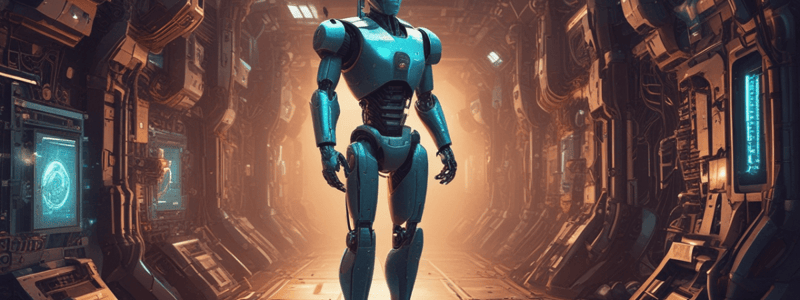Podcast
Questions and Answers
What is the main difference between the traditional computational approach and the Yokoi hand in grasping objects?
What is the main difference between the traditional computational approach and the Yokoi hand in grasping objects?
- The type of algorithm used to compute the object's shape
- The level of intelligence required to grasp the object
- The way the hand conforms to the object's shape (correct)
- The material used to construct the hands
What is the primary characteristic of subsumption architectures?
What is the primary characteristic of subsumption architectures?
- Requiring explicit top-down organization
- Using complex algorithms to map the environment
- Operating through stimulus-response mechanisms (correct)
- Relying on formal symbolic representation of intelligence
How are representations organized in subsumption architectures?
How are representations organized in subsumption architectures?
- Using complex neural networks
- As production rules or reflexes that map stimuli to behaviors (correct)
- Through isolated symbolic representations
- Through hierarchical planning systems
What is the purpose of the obstacle-avoidance layer in a subsumption architecture?
What is the purpose of the obstacle-avoidance layer in a subsumption architecture?
How do robots constructed with subsumption architectures respond to environmental stimuli?
How do robots constructed with subsumption architectures respond to environmental stimuli?
What is the relationship between the layers in a subsumption architecture?
What is the relationship between the layers in a subsumption architecture?
What was unique about SHAKEY, the robot developed by Stanford Research Institute?
What was unique about SHAKEY, the robot developed by Stanford Research Institute?
What was the main objection to traditional GOFAI approach to artificial agents like SHAKEY?
What was the main objection to traditional GOFAI approach to artificial agents like SHAKEY?
What is the term for the concept that small changes in initial conditions can lead to drastically different outcomes?
What is the term for the concept that small changes in initial conditions can lead to drastically different outcomes?
What is the name of the approach to robotics that proposes studying insects to understand how organisms interact with their environment?
What is the name of the approach to robotics that proposes studying insects to understand how organisms interact with their environment?
What is the term for using knowledge of living insects to create agents capable of moving about and solving problems in their environment?
What is the term for using knowledge of living insects to create agents capable of moving about and solving problems in their environment?
What is the term for exploiting features of body shape to simplify complex information-processing tasks?
What is the term for exploiting features of body shape to simplify complex information-processing tasks?
What was unique about the robot crickets built by Barbara Webb?
What was unique about the robot crickets built by Barbara Webb?
What is the name of the planner used by SHAKEY to translate a goal into a sequence of intermediate-level actions?
What is the name of the planner used by SHAKEY to translate a goal into a sequence of intermediate-level actions?
What is the term for the process by which complex behaviors emerge from the interactions between an organism and its environment?
What is the term for the process by which complex behaviors emerge from the interactions between an organism and its environment?
What is the term for the phenomenon where a small change in initial conditions can lead to drastically different outcomes in a nonlinear system?
What is the term for the phenomenon where a small change in initial conditions can lead to drastically different outcomes in a nonlinear system?
What is the primary characteristic of subsumption architecture robots?
What is the primary characteristic of subsumption architecture robots?
What is the primary limitation of subsumption architecture robots?
What is the primary limitation of subsumption architecture robots?
What is the main difference between situated and embodied robots?
What is the main difference between situated and embodied robots?
What is the primary goal of the Human Brain Project?
What is the primary goal of the Human Brain Project?
What is the main characteristic of Xenobots?
What is the main characteristic of Xenobots?
What is the potential application of Xenobots in medicine?
What is the potential application of Xenobots in medicine?
What is the uncanny valley effect?
What is the uncanny valley effect?
What is the primary explanation for the uncanny valley effect?
What is the primary explanation for the uncanny valley effect?
What is the primary difference between traditional central planners and subsumption architectures?
What is the primary difference between traditional central planners and subsumption architectures?
What is the primary advantage of behavior-based robots?
What is the primary advantage of behavior-based robots?
Flashcards are hidden until you start studying
Study Notes
GOFAI Robotics: SHAKEY
- SHAKEY was an early robot developed by the Stanford Research Institute around 1970.
- Named for its jerky movements and was the first robot capable of operating in a realistic environment rather than a controlled micro-world.
- Operated through software running on a separate computer, communicating via radio.
- Capable of planning, learning, and executing complex tasks, using a layered architecture organizing behaviors hierarchically.
- Low-level actions (LLAs) included basic movements and photo-taking; intermediate-level actions (ILAs) linked LLAs to form more complex routines.
- Featured the STRIPS planner, translating goals into sequences of ILAs while monitoring execution via PLANEX to assess errors and adjust actions.
- Critiqued for its inability to handle real-life problems and lack of adaptability, highlighting limitations of traditional AI.
Dynamical Systems
- Stepping reflex in infants exemplifies the U-shaped developmental trajectory, where reflexive movements appear and disappear at different growth stages.
- Research by Thelen and Smith showed that stepping is influenced by environmental factors, not solely cortical maturity.
- Dynamics of walking are outcome-based, emerging from complex interactions rather than pre-programmed commands.
- Dynamical models utilize calculus for tracking variables over time, promoting self-organization and emergent behavior.
- Nonlinear systems exhibit sensitive dependence on initial conditions, resembling chaotic behavior, often exemplified by the "butterfly effect."
Situated Cognition
- Situated cognition theorists advocate for a dynamical systems approach in robotics, focusing on simple, ecologically valid problems.
- Insects serve as models for natural intelligence, showing effective interaction with environments based on simple, hard-wired responses.
- Example: Female crickets directly move toward the loudest sound without complex processing, showcasing morphological computation principles.
- Barbara Webb's biorobotics employs insect knowledge to create robots capable of environmental interaction without traditional AI frameworks.
Architecture in Robotics
- Brooks' subsumption architecture comprises layered, semi-autonomous controls, prioritizing direct perception-action links over central planning.
- Hybrid architectures combine subsumption for low-level control and central planning for complex decision-making.
- Behavior-based robots represent their environments to guide actions without a central planner.
Human Brain Project
- Sponsored by the European Commission to simulate brain structures aiming for insights into cognitive functions and complex behaviors.
- Focuses on neuromorphic computing and neurorobotics to merge theoretical and data-driven approaches for learning and memory studies.
Living Robots: Xenobots
- Xenobots are less than 1mm biological machines created using frog embryo stem cells, designed via supercomputing evolutionary algorithms.
- They can self-organize to perform tasks, such as moving in coordinated fashions and even healing from damage.
- Potential applications include targeted drug delivery, waste cleanup, and biodegradable materials technology.
Uncanny Valley Effect
- As humanoid robots become more lifelike, they can evoke feelings of unease if they appear almost human but not quite, leading to the uncanny valley phenomenon.
- One explanation involves the instinctive evaluation of trustworthiness in nearly human-like entities.
Subsumption Architectures
- Robots like Webb’s crickets utilize subsumption architecture that integrates simple stimulus-response mechanisms rather than structured algorithms.
- Reactions arise from embodied knowledge, organizing behaviors into layers that directly connect perceptions to actions, such as obstacle avoidance.
Studying That Suits You
Use AI to generate personalized quizzes and flashcards to suit your learning preferences.




